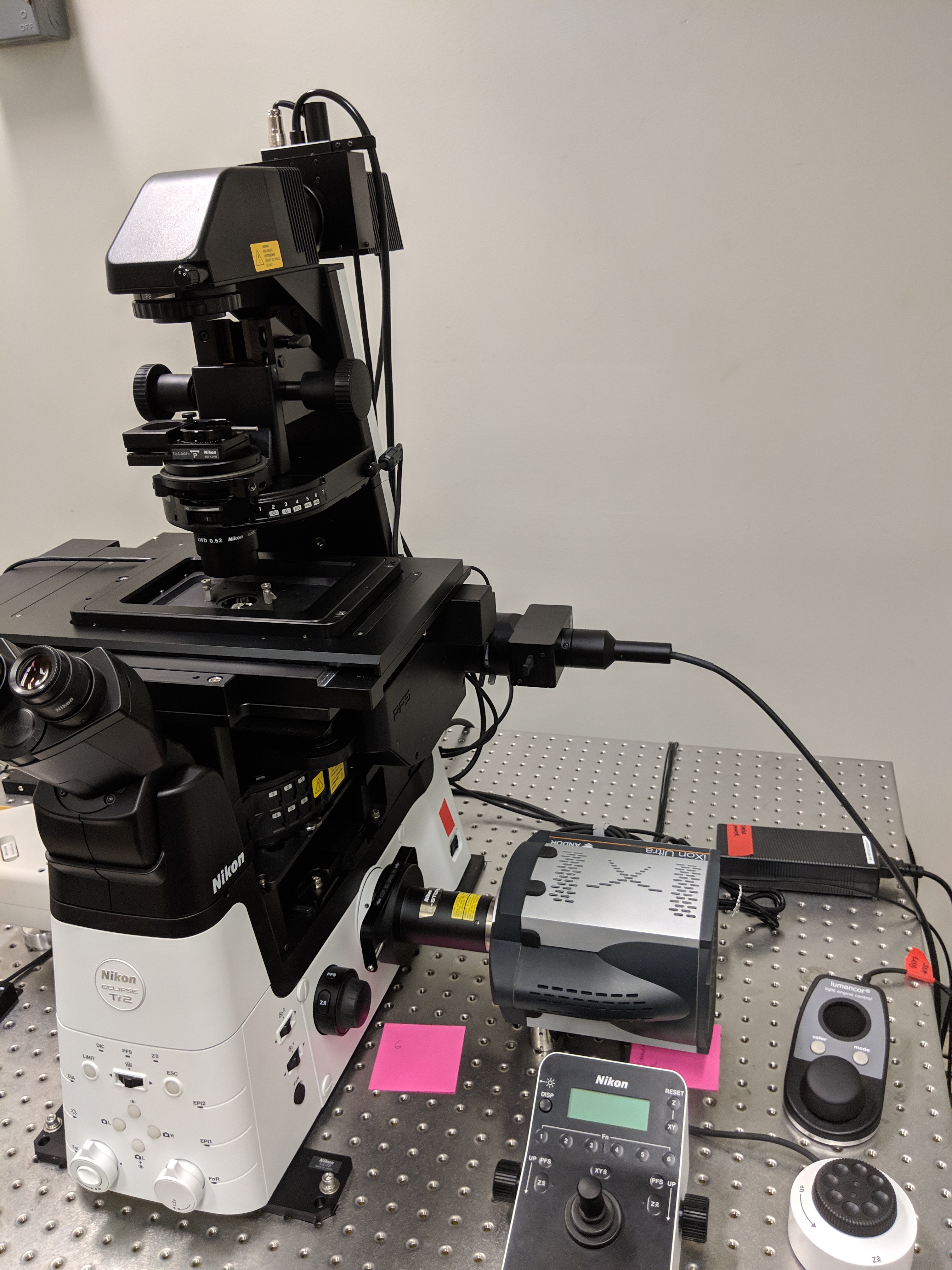
Stochastic Optical Reconstruction Microscopy (STORM) reconstructs a super-resolution fluorescence image by combining precise localization information for individual fluorophores in complex fluorescent specimens. N-STORM takes advantage of Nikon's powerful Ti2-Eclipse inverted microscope and applies high-accuracy, multi-color localization and reconstruction in three dimensions (xyz) to enable super-resolution imaging at tenfold the resolution of conventional light microscopes (up to approximately 20 nm in xy).
Features:
- Storm LU-NV Laser Launch System
- (TIRF) Total Internal Reflection Fluorescence Microscopy: TIRF is a special technique in fluorescence microscopy developed by Daniel Axelrod at the University of Michigan, Ann Arbor in the early 1980s. TIRF microscopy delivers images with a high axial resolution below 100 nm. This allows the observation of membrane-associated processes.
- 3 channels of detection:488nm, 551nm, 647nm
- Spectral FRET Analysis
Objectives:
- Apo Tirf 100x oil DIC n2 na 1.5 wd 120um
- SR HP Apo Tirf 100x AC na 1.5 wd 120
- 60x Apo Tirf 60x oil DIC n2 na 1.5 wd 120um
- 20x plan Apo vc 20x DIC n2 na o.8 wd 1000um
LU-NV Laser Launch System:
405nm, 488nm, 561nm, 647nm
Accessories:
- Perfect Focus System
- Nikon Eclipse Ti2 inverted microscope
- Motorized x-y stage with encoders
- Piezo Z-stage
- Tokai Hit Environmental Chamber
- N-Storm Andor iXon Ultra emccd camera used for Storm, Tirf and Widefield
- 2d Storm, 3D storm, Z-Stack
- Simultaneous STORM/TIRFF
Tenfold improvement of axial resolution up to 50nm: In addition to lateral super-resolution, N-STORM utilizes proprietary methods to achieve a tenfold enhancement in axial resolution over conventional light microscopes and provide nanoscale information in 3D. The 3D-Stack function allows multiple 3D STORM images from different Z positions to be captured and stitched into one image to create thicker STORM images. Tenfold improvement of lateral resolution up to 20nm: N-STORM utilizes high accuracy localization information for thousands of individual fluorophores present in a field of view to create breathtaking "super-resolution" images, exhibiting spatial resolution that is 10 times greater than conventional optical microscopes. Dynamic super-resolution imaging: Newly developed optics and illumination systems, optimized for sCMOS technology, have increased image acquisition speeds by up to 10 times. With acquisition times reduced from minutes to seconds*, dynamic events in live specimens can now be captured with molecular level resolution. Multi-color imaging capability: Multi-color super-resolution imaging can be carried out using both activator-reporter pairs for sequential activation imaging and activator-free labels for continuous activation imaging. This flexibility allows users to easily gain critical insights into the localization and interaction properties of multiple proteins at the molecular level. High definition, high density images: Newly developed excitation optics and improved image acquisition rates provide increased molecule localization density, resulting in clearer images of macromolecular structures. Large image acquisition area: New intermediate zoom lenses in the imaging system have been developed and optimized for a wide field of view. The wide-view mode achieves 80 μm x 80 μm, a 4-fold increase in imaging area compared to previous models. Seamless switching between imaging modalities for multi-scale experiments: The N-STORM can be simultaneously combined with a confocal microscope such as the A1+. A desired location in a sample can be specified in a low-magnification/large FOV confocal image and acquired in super-resolution by simply switching the imaging method. Combining a confocal microscope with a super-resolution system can provide a method for gaining larger contextual views of the super-resolution information. High Power Oil immersion objectives: These objectives provide the high numerical apertures required for N-STORM imaging. The HP objectives are compatible with the ultrahigh power lasers required for inducing rapid photoswitching of fluorophores. They provide improved axial chromatic aberration correction to achieve the highest level of precision in localization and image alignment for 3D multi-color STORM imaging. The AC-type objectives that support the Auto Correction Collar of the Ti2-E microscope allow precise and easy adjustment of the correction collar.

